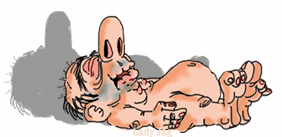|
SERVING THE BEST TROOPS IN THE WORLD  An Around the World Tour with our United States Armed Forces! Our Troops are stationed all over the world, let's go visit them! Today's stop - Camp Schwab - Okinawa |
 Maido! Welcome to Camp Schwab! 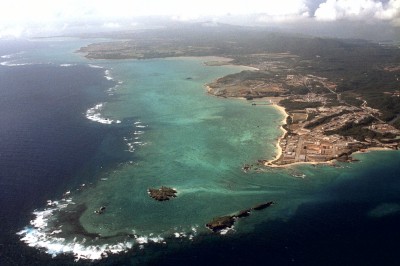 Situated on the southern approaches to Japan, the Ryukyu Island chain was geographically situated as to be virtually unavoidable in any American offensive strategy against mainland Japan. The inevitable soon became history when Okinawa became the arena for one of the most ferocious battles of the war. By June, 1944, the Japanese army arrived in force. In March, 1945, the first American troops landed on the Kerama Islands as the springboard for America's island leapfrogging strategy. Okinawa was next in line and, on April 1, 1945, the invasion began. After 11 weeks of fierce fighting, the battle of Okinawa was over June 20, 1945. Two months later Japan surrendered. Okinawa was one of the longest and hardest fought campaigns in the history of World War II. The island has been a favorite training area for the Marine Corps since post-war units were based here more than 40 years ago. Today, the Corps has eight different facilities on Okinawa to call home: Camps Gonsalves, Schwab, Hansen, Courtney, Lester, Foster, Kinser, and Marine Corps Air Station, Futenma. Beside a significant Marine Corps presence here, Okinawa is also home to a number of major Navy, Army, and Air Force units and facilities. In October 2005, Air Station Futenma moved to Camp Schwab. Marine Corps Bases Japan Home Page 
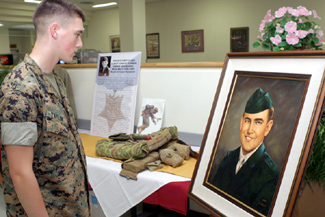 Many heroes arose in World War II during the battle of Okinawa. One hero, Pfc. Albert E. Schwab, died for his country and is still remembered for his valor today. Schwab, a flamethrower operator with Headquarters Company, 1st Battalion, 5th Marine Regiment, 1st Marine Division, received the Medal of Honor posthumously for his actions against enemy Japanese forces on Okinawa May 7, 1945. Although severely wounded by a final vicious blast, Schwab succeeded in destroying two highly strategic Japanese gun positions during a critical stage of the operation. By his dauntless, single-handed efforts, Schwab furthered the advancement of his company. 
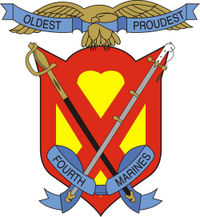 |
The 4th Marine Regiment was first activated in April 1914 as part of the Marine Corps' Advances Base Force. In late 1941, war loomed in the Far East. On November 28, the era of the China Marines ended, as the last of the regiment set sail for the Philippines. In the battle at Corregidor, Gen. Jonathan Wainwright, commander of U.S. Forces in the Philippines, surrendered. The 4th Marines burned their colors and -- temporarily -- ceased to exist. The regiment was reborn in February 1944, when it was reconstituted in Guadalcanal from units of the 1st Marine Raider Regiment. In 1951, the 4th Marine Regiment was reactivated at Camp Pendleton, California. It sailed for Japan the following year with the rest of the 3rd Marine Division. When the division was reassigned to Okinawa in 1955, the 4th Marines moved to Kaneohe, Hawaii, where they stayed until the division was committed to Vietnam in 1965. In 1972, the regiment took up residence on Okinawa, its current home base. In 1990-91, the 4th Marines took part in Operations Desert Shield and Desert Storm as part of the III Marine Amphibious Force. Since then, 4th Marine Regiment has been involved in many joint exercises that have taken the regiment all across Asia and the Middle East. |
| |
|
| 3rd Reconnaissance Battalion (3rd Recon) is an infantry battalion in the United States Marine Corps based out of Camp Schwab, Okinawa, Japan consisting of approximately 300 Marines and Sailors. They fall under the 3rd Marine Division. The battalion conducts amphibious reconnaissance, deep ground reconnaissance, surveillance, battlespace shaping, and limited scale raids in support of III MEF, 3rd Marine Division, and other Marine Air-Ground Task forces. |
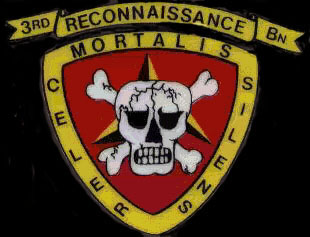 |
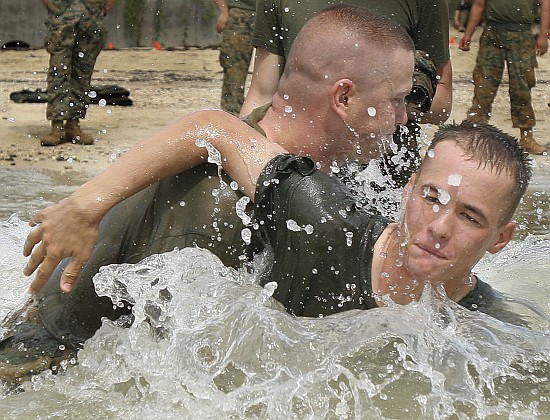 Sgt. Ryan M. Gummer, left, throws Lance Cpl. John W. Reid into the ocean water at a Camp Schwab. About 70 Marines from the Camp Butler Provost Marshal’s Office participated in a daylong training event where they completed two obstacle courses, weapons training and hand-to-hand fighting techniques. Gummer is an accident investigator, and Reid is a Drug Abuse Resistance Education officer with PMO. 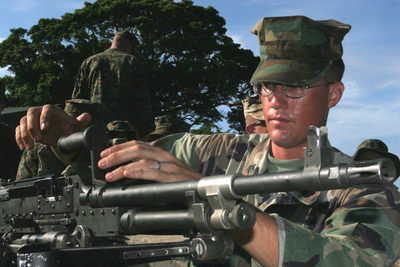 Sergeant Matthew M. Anderson teaches a group of Marines how to change the barrel of the M240G medium machinegun at Camp Schwab’s Range. Forty-five Marines with Headquarters and Service Company, Headquarters Battalion, 3rd Marine Division learned how to operate a variety of weapons systems during a four-day weapons familiarization exercise at ranges on Camps Schwab and Hansen.
 Location: Okinawa Prefecture is Japan's southernmost prefecture, and consists of hundreds of islands known as the Ryūkyū Islands or Ryūkyūs, in an island chain over 1,000 km long, which extends southwest from Kyūshū (the southwestern most of Japan's main four islands) to Taiwan, although the northern islands in the chain are part of Kagoshima Prefecture. Okinawa's capital, Naha, is located in the southern part of the largest and most populous island, Okinawa Honto, which is approximately half-way between Kyūshū and Taiwan. The disputed Senkaku Islands are also administered as part of Okinawa Prefecture. 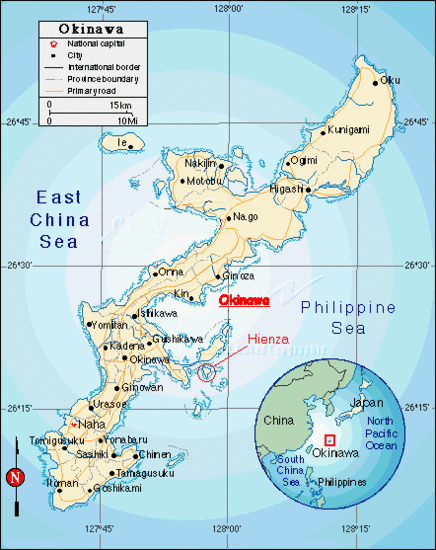 Background: The U.S. military presence in Japan and on Okinawa began at the end of World War II. Although the US occupation in Japan ended in 1952, U.S. administration continued on Okinawa until 1972. In 1951, when the San Francisco Peace Treaty was officially recognized, Okinawa legally became a possession of the United States. In 1972, control of Okinawa was reverted to Japan. The U.S. - Japan security relationship is defined by a number of documents, including the Treaty of Mutual Cooperation and Security, which commits both countries to meet common dangers, and a Status of Forces Agreement that governs the legal status of U.S. forces and their dependents stationed in Japan. The U.S. forces on Okinawa occupy about 10 percent of the land in the prefecture. Japan provides part of the cost of the forward deployment of U.S. forces throughout Japan, through an annual burden-sharing payment.  Government category: Okinawa is a prefecture (state) of Japan, and has a Governor. Flag: The symbol on the Okinawan flag of today brought out a great deal of discussion and even threats of law suits while it was being formulated. The initial colors used blue as the outer disk. As such, if placed on its side, disks towards the hoist, it would have been identical with the the Mon used by the most prominent Okinawan martial arts organization. This quite possibly reflects that that organization was really the only native organization which received equal status with organizations throughout Japan. From 1879 until 1945, the Japanese had strived to squelch the Okinawan culture, and to impose their own. This was especially true through education, where children would be severely punished if they used the Okinawan language in school, even among themselves. The colors were changed to Red on White on Red, but the significance to the Okinawans remains clear - if they are to be a part of Japan, then they are equal to any other prefecture in the nation.
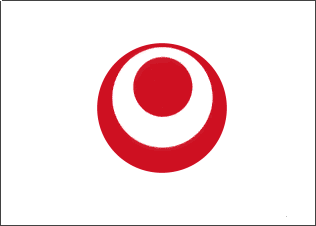  Weather: Okinawa is in the subtropical climate zone, and has comfortable weather for Troops and their families throughout the year. In Japan, Okinawa is the only prefecture that is located in the subtropical climate zone. The average annual temperature of Okinawa is 22 C (72 F). Even during the winter, the temperature averages 16 C (60 F) and never dips below 10 C (50 F) 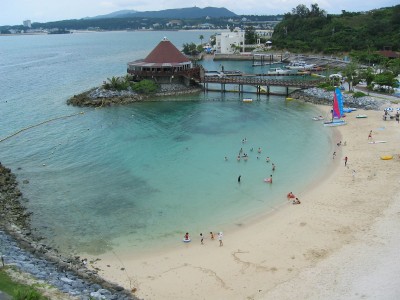 Ethnicity: Due to its location and history, Okinawa is also more ethnically diverse than other parts of Japan. Okinawans are a unique blend of Malay from Formosa and Philippines, Chinese from China, and Japanese from Japan.
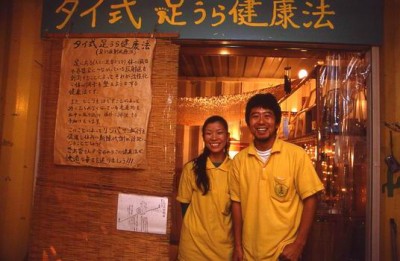 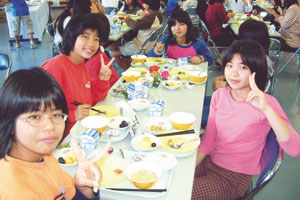 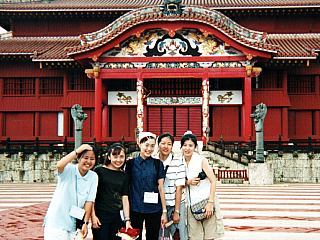 Languages: The language of Okinawa belongs to the Japanese-Ryukyuan language family which extends from Hokkaido in northern Japan to Yonaguni (73 km. off the coat of Taiwan) in the southern Ryukyus. Having historically been a separate nation (and the Ryūkyū Kingdom having had closer ties with China than with Japan), Okinawan language and culture differ considerably from that of mainland Japan. There remain numerous Ryukyuan languages which are more-or-less incomprehensible to Japanese speakers. These languages are in decline as the Japanese government has encouraged the use of Standard Japanese.
Economy: The Okinawa economy has been dependent on U.S. military bases in the postwar period, and after reversion to Japan in 1972, also came to rely heavily on public works spending (especially of the central government). The economy has a small manufacturing sector and an very large tourism industry.
 Okinawa is ichiban! There are many things about Okinawa that make it unique, providing Okinawan culture, recreation, and fun for our Troops and their families stationed there! 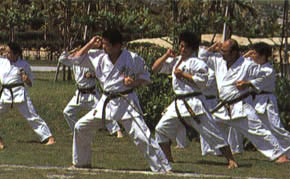 It is said that Karate is the mix of "Ti," the Ryukyuan (Okinawan) traditional fighting art, and "Kenpo," the Kung Fu traditional fighting art of China. Karate was developed in Okinawa. When it was introduced to mainland Japan, they called it Karate meaning "empty hand." Karate has spread through the world after World War II. Okinawa is known as the root of Karate. Many people from all over the world come to Okinawa to train; and, international competitions are often held in Okinawa. 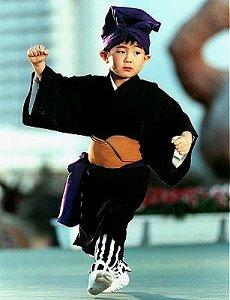   In 1975, the World Exposition was held in Okinawa, centering around the theme of seas and oceans. After the expo's closure, the Ocean Expo Park was built on the former expo site, in order to commemorate the event. The most famous among the various attractions found in the Ocean Expo Park, is the Okinawa Churaumi Aquarium, one of Japan's largest and best aquaria. Other attractions include a tropical flower park, a maritime museum, a sand beach and a historic Okinawan village. 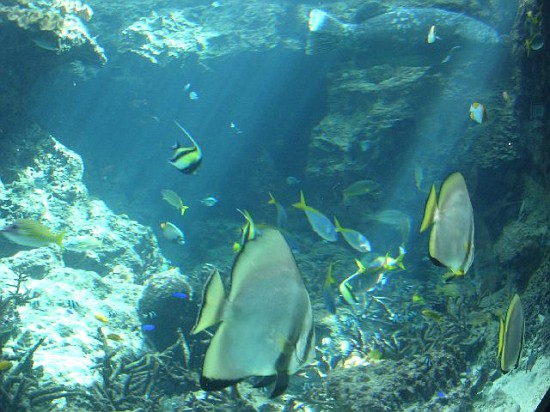  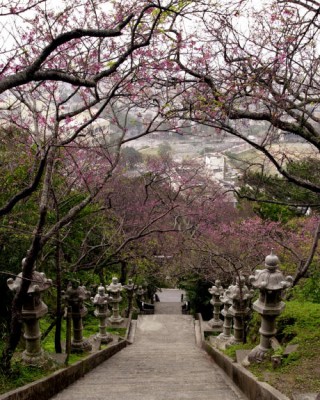 Nago Central Park is in the hills overlooking Nago City and the East China Sea. Visitors can spend a nice day exploring the park on foot, and is a great place to stop with the kids on the way to Ocean Expo Park. The playground equipment is unique. The trails throughout the park are well marked, mostly paved, and wind up & down throughout the hills. Most signs are in English and Japanese, which does come in handy. For the Okinawa residents, the Cherry Blossom Festival ranks as one of the most beautiful events of the year, with Mother Nature showing her colors with the traditional flowers. The “best viewing” forecasts blooms through mid February , although the cherry blossoms are on the trees across Nago and nearby Mount Yaedake through late February. 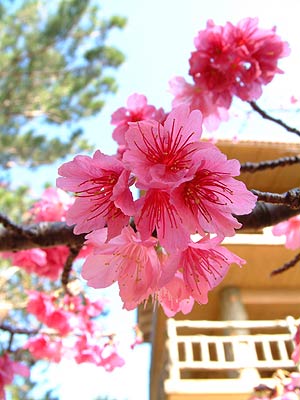  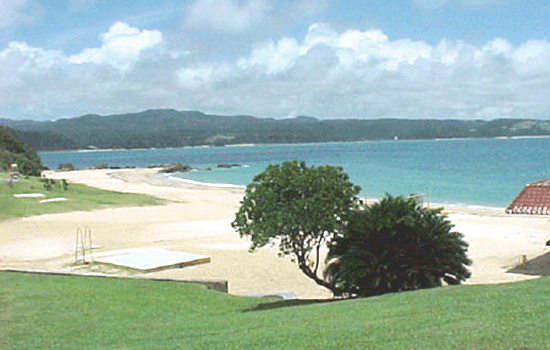 Oura Wan Beach is Camp Schwab’s on-base facility. Operated by Marine Corps Community Services, the beach offers swimming, fishing and boating activities as well as snorkeling. Sailboats, jet skis, power boats, windsurfing boards and kayaks can be rented, and there’s a fishing bait and tackle shop on site. The beach has lifeguards, and charter boat rentals are also offered from Oura Wan Beach. 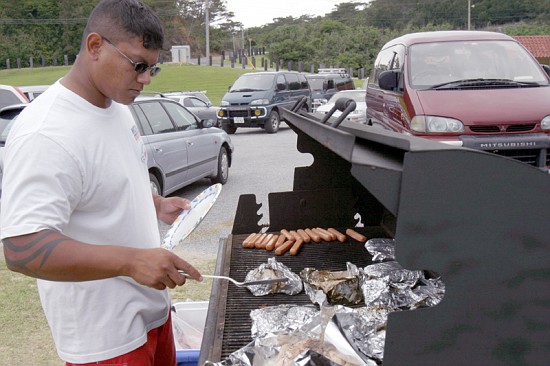  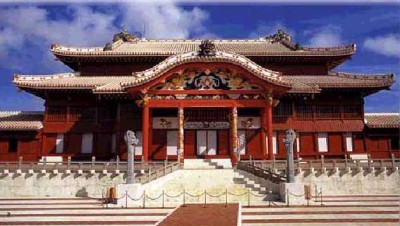 Shuri Castle was built on a plateau about 120 meters above sea level. It is the largest of Okinawa's castles. The castle compound has an elliptical shape and is some 350 meters east-west and 200 meters north-south. When, and by whom, the castle was first built here is still uncertain, but excavation work indicates that a precursor of Shuri Castle was in existence by the second half of the 14th century. The Shuri Castle Festival commemorates the Ryukyu Kingdom era and is held annually in October. The festival dates back to the 1600’s, when Sho Hashi used his leadership skills to bring together three Sanzan Kingdoms peacefully. Shuri Castle was the hub of royal activity, and home of 19 Ryukyuan kings for an era that spanned nearly 500 years. 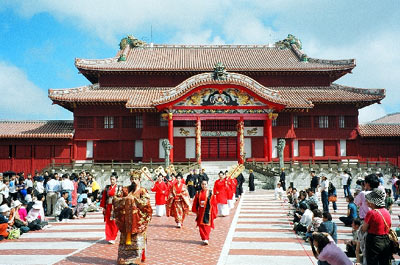  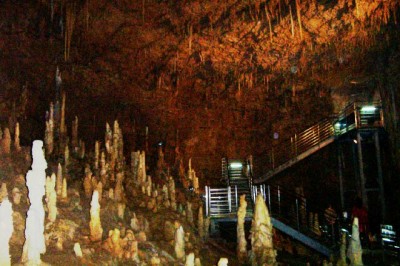 The Gyokusendo cave is more than 300,000 years old and is the second largest in Japan. The cave is five kilometers long, with 890 meters open to the public. The cave, which claims to have the greatest stalactites and stalagmites in Asia, features many unique stalactite and stalagmite formations, including the Speared Ceiling, which has more than 20,000 stalactites hanging from the ceiling like a forest of stone icicles.   Dining and night life are also unique experiences for our Troops in Okinawa!
 |
Kazin Oh Restaurant is not someplace you’ll get to by accident. In fact, you must really, really want to go there. It is miles from anywhere, practically, and you must drive up the side of a mountain to experience the savory salad and pizza with pizzazz.
The restaurant is located on the Motobu Peninsula west of Nago City. We mention this because you don’t decide to go there when you’re already hungry. The food is worth the drive though. Once on the final leg, past Nago and en route to the Ocean Expo Park, you’re almost there. A strategic right turn and a spin up the mountainside following very small Japanese signs in kanji (don’t worry, they’re the only signs along the roadside) brings you to Kazin Oh. |
| |
|
| Nago City Public Market: Yanbaru's Kitchen Downtown Nago is the economic center of northern Okinawa, and although limited in size, the Nago City Public Market is always lively. A large variety of foods are found here, as the market is commonly referred to as the "kitchen of Yanbaru locals." |
 |
| |
|
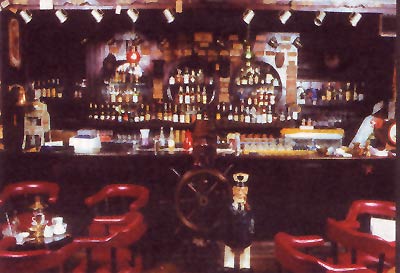 |
Sam’s Café just outside Camp Foster’s Legion Gate is offering a combination seafood dinner and tenderloin steak. The anniversary special price is ¥2,100. Not to be outdone, Sam’s Anchor Inn in Ginowan on Highway 58 is offering a sumptuous spread with jumbo prawns and tenderloin steak for only ¥3,450. |
| |
|
Himitsu Kichi is an izakaya with a unique décor. It lives up to its name, which in English is ‘secret place.’ Americans are finding this secret place though, located in basement of the Eagle Lodge building on Highway 23 near Kadena.
The décor’s a blend of Asian fusion, and the menu runs pretty much the same. Himitsu Kichi serves from an ala carte menu, with individual entrée prices ranging from Y390~470 in one section, and Y439~700 in another. |
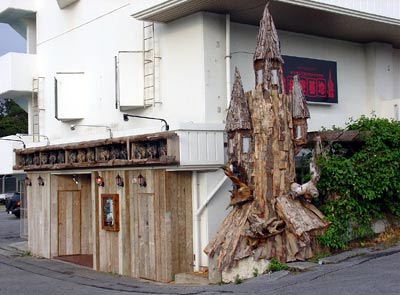 |
| |
|
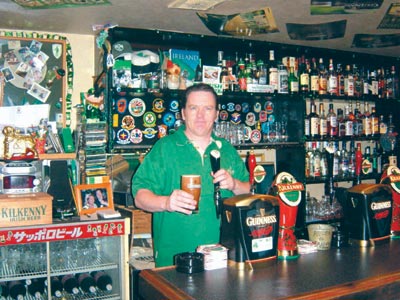 |
There’s to be plenty of Irish food at the Paddy Mac's Pub, located on Park Avenue in Okinawa City, near the New York Restaurant. Owner Martin McIntyre does the cooking himself, and serves up corn beef and cabbage dinners both Friday and Saturday, as well as traditional Irish beef stew. McIntyre is an Ireland native who’s been on Okinawa some 10 years now. |
| |
|
| Sponsored by Marine Corps Community Services and the Butler Officers Club, an annual wine extravaganza brings dozens of the most tantalizing wines in international vendors’ inventory to Okinawa. The Okinapa Wine Festival is both a wines and culinary event, where MCCS’s top chefs take gastronomical delights well beyond traditional fruits and cheeses. |
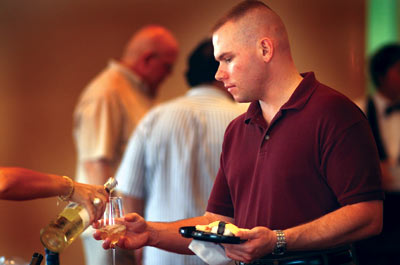 |
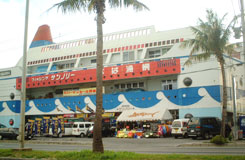 |
NiCHe Bar and Cafe in Chatan Town - NiCHe Bar and Cafe is a non-smoking café by day, and bar by night. Entertainment varies, with no two evenings the same. Expect theme parties and special events, interwoven with the musical beats of trance, house, jazz, modern pop, R & B, hip-hop and other musical genre. Resident disc jockeys Nostromo and Selrahc are the primary spinners of the tunes, while guest DJ’s will drop by for weekend performances. |
 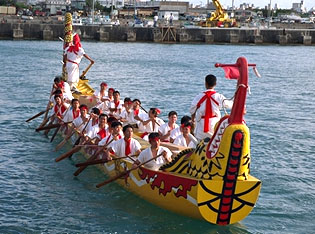 Itte rasshai We hope you have enjoyed the visit with our Troops!  FR CANTEEN MISSION STATEMENT~Showing support and boosting the morale of our military and our allies military and the family members of the above. Honoring those who have served before. Please remember: The Canteen is a place to honor and entertain our troops. Let's have fun!  We pray for your continued strength, to be strong in the face of adversity. We pray for your safety, that you will return to your families and friends soon. We pray that your hope, courage, and dignity remain unbroken, so that you may show others the way. God Bless You All ~ Today, Tomorrow and Always |
